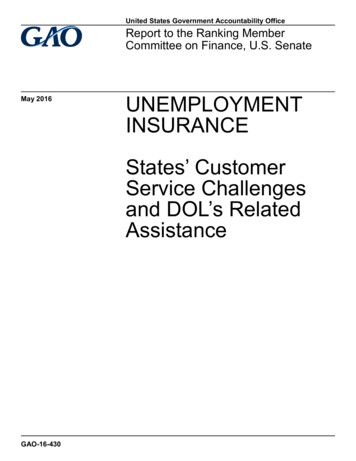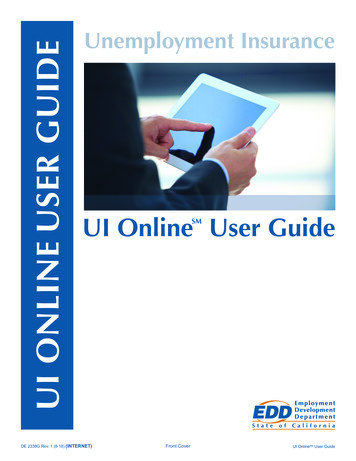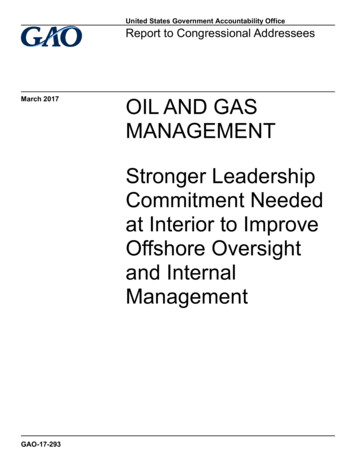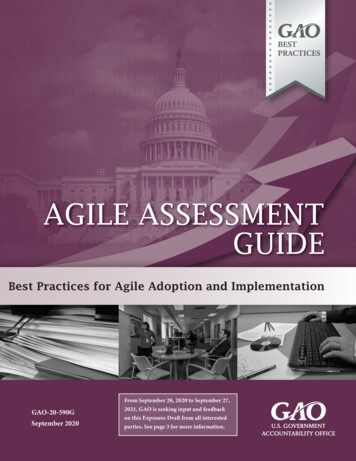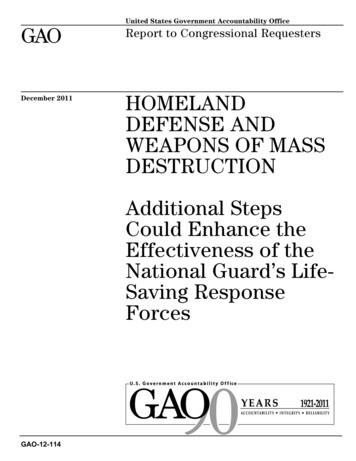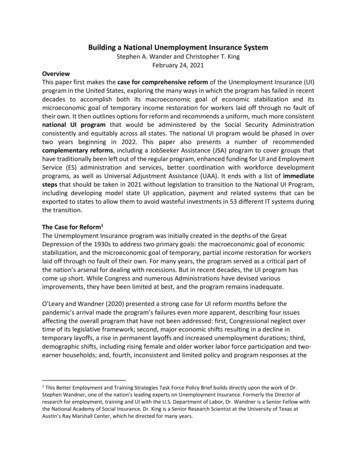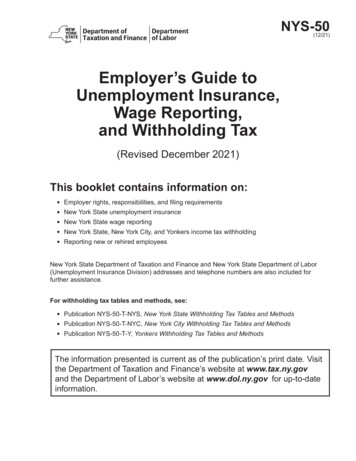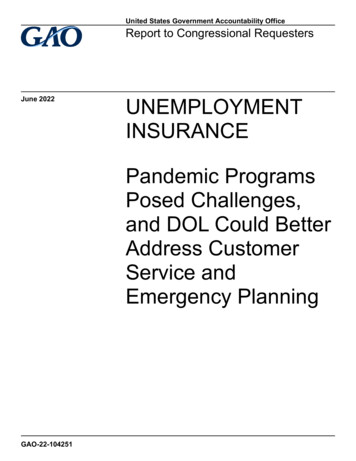
Transcription
United States Government Accountability OfficeReport to Congressional RequestersJune 2022UNEMPLOYMENTINSURANCEPandemic ProgramsPosed Challenges,and DOL Could BetterAddress CustomerService andEmergency PlanningGAO-22-104251
June 2022UNEMPLOYMENT INSURANCEHighlights of GAO-22-104251, a report tocongressional requestersPandemic Programs Posed Challenges, and DOLCould Better Address Customer Service andEmergency PlanningWhy GAO Did This StudyWhat GAO FoundIn the wake of the COVID-19 pandemicand subsequent shutdowns, the nationexperienced historic levels of job lossand an expansion of the UI system.The CARES Act created three new,federally funded temporary UIprograms that expanded eligibility,enhanced benefits, and extendedbenefit duration. DOL has reportedabout 658 billion in compensationpaid as of April 30, 2022.State officials GAO interviewed in six selected states that varied acrosscharacteristics, such as IT modernization, described facing shortages ofexperienced staff and IT challenges in processing the surge in claims whileimplementing the CARES Act Unemployment Insurance (UI) programs.Challenges in implementing federal guidance and maintaining program integritywere also cited. Officials in all of the six states reported that they increasedstaffing. States also added functionality to their IT systems. Despite these effortsto respond to the challenges, claimants in GAO’s discussion groups andadvocates in the six states reported persistent customer service problems, suchas long call wait times.The CARES Act includes a provisionfor GAO to monitor federal efforts inresponse to the COVID-19 pandemic.This report examines (1) selectedstates’ challenges with implementingthe temporary UI programs and effortsto address those challenges; (2) DOL’ssupport and monitoring of theprograms, including efforts to addressimproper payments; and (3) theeconomic effects of expanding UIbenefits in adverse times.Unemployment insurance applicationGAO interviewed DOL officials and metwith officials in six states that wereselected to include a variety ofcharacteristics, such as their ITmodernization, payment timeliness,and estimated improper payment rates.GAO held discussion groups with UIrecipients in the selected six states;analyzed data DOL collects fromstates; reviewed relevant federal lawsand program guidance; and reviewedeconomic literature.What GAO RecommendsGAO is making two recommendationsto DOL to identify and provide UIcustomer service best practices andassess lessons learned from thepandemic. DOL partially agreed withthe first recommendation, and agreedwith the second, and noted plans toaddress them.View GAO-22-104251. For more information,contact Thomas Costa, 202-512-4769,costat@gao.govThe Department of Labor (DOL) took steps to support and monitor states’implementation of the CARES Act UI programs. However, it could have betterassisted states with customer service challenges and lacked a strategic approachwhen responding to the pandemic. DOL is responsible for ensuring customersatisfaction in the UI system, and has taken steps to incorporate customer serviceinto its UI modernization efforts, including providing states with technical assistanceand funding opportunities. However, it has not identified and provided states withcomprehensive customer service best practices. Without sharing best practices, DOLmay miss opportunities to assist states in improving service delivery during periods ofhigh demand. In addition, while as of March 2022, DOL had not assessed itsresponse to the pandemic, as generally recommended by the National ResponseFramework, in May 2022, DOL officials said DOL had begun to do so. Until such areview is completed, DOL and states may not be well positioned to address futureemergencies.The 30 empirical studies reviewed by GAO showed the effect of the expansion of UIprograms during adverse times, such as the 2007-2009 recession and the COVID-19pandemic. The expansions specifically helped to stabilize the economy, preventeddetrimental outcomes from worsening, and had a limited effect on workers’ incentivesto return to work. Some of the studies also showed that UI expansion had otherpositive benefits such as an improved labor market.United States Government Accountability Office
ContentsLetter1BackgroundSelected States Reported Numerous Challenges in ImplementingCARES Act UI ProgramsDOL Provided Various Supports to Help States Implement theCARES Act UI Programs and Prevent Improper Payments, butCould Have Better Responded to Customer Service ChallengesEmpirical Studies Show UI Expansion in Adverse Times CreatedEconomic Stability, While Resulting in Limited Negative Effectson Workers’ Return to EmploymentConclusionsRecommendations for Executive ActionAgency Comments47525353Appendix IObjectives, Scope, and Methodology58Appendix IICharacteristics of Discussion Group Participants63Appendix IIITimeline of Selected Events Related to CARESAct Unemployment Insurance (UI) Programs,January 2020-December 202166Appendix IVDetailed Information about Empirical Studies Reviewed68Appendix VStudies Included in Literature Review80Appendix VIComments from the Department of Labor84Appendix VIIGAO Contact and Staff Acknowledgments89Page i31132GAO-22-104251 Unemployment Insurance
TablesTable 1: Unemployment Insurance (UI) Initial Claims Volumebetween March-May 2019 as Compared to March-May2020Table 2: Department of Labor (DOL) Guidance for the CARES ActUnemployment Insurance (UI) Programs Issued betweenApril 2020 and September 2021Table 3: Summary of Interviews and Discussion GroupsConducted in Site Visit StatesTable 4: Discussion Group Participant Characteristics: Race andEthnicityTable 5: Discussion Group Participant Characteristics: Number ofdependentsTable 6: Discussion Group Participant Characteristics: IndustrySector Before Becoming UnemployedTable 7: Discussion Group Participant Characteristics: Incomebefore Becoming UnemployedTable 8: Discussion Group Participant Characteristics: Number ofWeeks of CARES Act Unemployment Insurance ProgramBenefits Received1333586363646465FiguresFigure 1: Dates of Initial Payments under the CARES ActPrograms in Selected StatesFigure 2: Percentage of Regular Unemployment Insurance FirstPayments to Claimants that Met the 21 Day TimeframeCompared to DOL’s 87 Percent Standard, SelectedStates, January 2020 through August 2021Figure 3: Selected Events Related to CARES Act UI Programs,January–December 2020Figure 4: Selected Events Related to CARES Act UI Programs,January–December 2021Page ii19236667GAO-22-104251 Unemployment Insurance
UAUIUIPLBenefit Accuracy Measurement SystemDepartment of LaborDisaster Unemployment AssistanceEmployment and Training AdministrationFederal Pandemic Unemployment CompensationIntegrity Data HubInternet ProtocolNational Association of State Workforce AgenciesOffice of Inspector GeneralOffice of Management and BudgetPandemic Emergency Unemployment CompensationPandemic Unemployment AssistanceUnemployment InsuranceUnemployment Insurance Program LetterThis is a work of the U.S. government and is not subject to copyright protection in theUnited States. The published product may be reproduced and distributed in its entiretywithout further permission from GAO. However, because this work may containcopyrighted images or other material, permission from the copyright holder may benecessary if you wish to reproduce this material separately.Page iiiGAO-22-104251 Unemployment Insurance
Letter441 G St. N.W.Washington, DC 20548June 7, 2022Congressional RequestersFollowing the emergence of the COVID-19 pandemic in the United Statesin early 2020, and related public health measures taken to contain andmitigate its transmission, the nation experienced historic levels of job lossand an expansion of the unemployment insurance (UI) system. TheCARES Act, enacted on March 27, 2020, created three new federallyfunded temporary UI programs that expanded UI benefit eligibility,enhanced benefits, and extended benefit duration. 1 The temporaryprograms supplemented the existing UI program, known as “regular” UI,which is a federal-state partnership that provides temporary financialassistance to eligible workers who become unemployed through no faultof their own. 2 The federal government funded the administration of andbenefits for the new programs and relied on states to determineclaimants’ eligibility, process claims, and issue benefits to individuals. TheDepartment of Labor (DOL) has reported about 658 billion incompensation paid under the CARES Act UI programs as of April 30,2022. 3The CARES Act included a provision for GAO to conduct monitoring andoversight of the use of funds made available to prepare for, respond to,and recover from the COVID-19 pandemic. 4 This report examines: (1)challenges selected states reported in implementing the CARES Act UIprograms, and actions they took to address those challenges; (2) how1Pub.L. No. 116-136, §§ 2102, 2104, 2107, 134 Stat. 281, 313-28.2Inthis report, we refer to the UI program—excluding the temporary UI programs createdby the CARES Act and other legislation—as the regular UI program and the benefits paidunder the program as regular UI benefits.3DOL,Employment and Training Administration, “Families First Coronavirus Response Actand Coronavirus Aid, Relief, and Economic Security (CARES) Act Funding to States,”accessed May 3, 2022:https://oui.doleta.gov/unemploy/docs/cares act funding state.html.4Pub.L. No. 116-136, § 19010(b), 134 Stat. 579-81. We have regularly issuedgovernment-wide reports on the federal response to COVID-19. For the latest report, seeGAO, COVID-19: Current and Future Federal Preparedness Requires Fixes to ImproveHealth Data and Address Improper Payments, GAO-22-105397 (Washington, D.C.: Apr.27, 2022). Our government-wide reports are available on GAO’s website athttps://www.gao.gov/coronavirus. In addition, several congressional committees andmembers requested that we review unemployment insurance programs, which we list inthis report.Page 1GAO-22-104251 Unemployment Insurance
DOL supported and monitored states’ implementation of the CARES ActUI programs, including detection and prevention of improper payments;and (3) what is known about the economic effects of the expansion of UIbenefits for individuals and the economy during adverse times.For our first two objectives, we reviewed relevant federal laws,regulations, and guidance, and interviewed officials from DOL and itsOffice of Inspector General (OIG). We also interviewed officials from theNational Association of State Workforce Agencies (NASWA), whichrepresents state UI agencies. We selected six states (Arizona, Florida,Massachusetts, Michigan, Minnesota, and Wyoming) to reflect diverseconditions based on a range of characteristics, including averageunemployment rate; COVID-19 cases per capita; varying stages of UIagency IT modernization; the reported estimated improper payment rate;and timeliness of benefit payments in the regular UI program. For all sixstates, we interviewed state UI agency officials, and in five of thosestates, we interviewed advocates for UI claimants and state attorneygeneral officials. 5 For Arizona and Florida, we interviewed advocates forSpanish-speaking UI claimants about those claimants’ experiences inapplying for and receiving benefits. Additionally, we conducted 12 virtualdiscussion groups (two in each of the six states) in May and June 2021with individuals who had received UI benefits in the six selected states tounderstand participants’ experiences with applying for and receivingbenefits, and with contacting state UI agencies for customer serviceregarding their claims. Discussion group results are not generalizable toUI recipient experiences in the six states or nationwide; however, theresults provide insights about the experiences of some UI recipients.Appendix II provides a description of the characteristics of the participantsin our 12 discussion groups. Additionally, we analyzed data on paymenttimeliness and claims for selected states. We conducted a reliabilityassessment for all of the data elements used in our study and determinedthat data were sufficiently reliable for the purposes of this report.To address our third objective, we conducted a literature review to identifykey government, industry, and academic studies examining the effects ofexpanded UI benefits for individuals and the economy during adverse5Wewere unable to identify an advocate for UI claimants in Wyoming, and we did notinterview officials of the Minnesota Office of Attorney General. According to officials ofMinnesota’s unemployment insurance agency, the state attorney general plays no role inprosecuting UI fraud, the Bureau of Criminal Apprehension, within the Department ofPublic Safety, can issue arrest warrants when the state unemployment insurance agencyidentifies fraud, and prosecutions are conducted by district attorneys at the county level.Page 2GAO-22-104251 Unemployment Insurance
times. We searched relevant databases, such as ProQuest, ECONlit,Scopus, and Dialog to identify scholarly and peer-reviewed research,working papers, government reports, trade and industry articles, as wellas association and non-profit publications published in the last 20 years.From our initial search that yielded over 500 articles, we identified 65 forfurther in-depth review based on our criteria, such as academicpublication, data analysis, and focus on the United States as the countryof analysis. After the in-depth review, we determined that 30 studiesfulfilled our criteria for inclusion in our literature review. These in-depthreviews entailed an assessment of each study’s research methodology,including its data quality, research design, and analytic techniques, aswell as a summary of each study’s major findings and conclusions. Wealso assessed the extent to which each study’s data and methodssupported its findings and conclusions. We based our data collection andassessment on generally accepted social science standards.Appendix I provides a more detailed discussion of the objectives, scope,and methodology of our review. Appendix IV provides detailed informationabout the studies we reviewed, and appendix V provides the bibliography.We conducted this performance audit from March 2020 to June 2022 inaccordance with generally accepted government auditing standards.Those standards require that we plan and perform the audit to obtainsufficient, appropriate evidence to provide a reasonable basis for ourfindings and conclusions based on our audit objectives. We believe thatthe evidence obtained provides a reasonable basis for our findings andconclusions based on our audit objectives.BackgroundFederally Funded UIPrograms in Response toCOVID-19The CARES Act created three new federally funded temporary UIprograms that expanded UI benefit eligibility and enhanced benefits. 6These programs were subsequently extended and amended by theConsolidated Appropriations Act, 2021, as well as the American RescuePlan Act of 2021, and expired in September 2021. 7 However, 24 states6Pub.L. No. 116-136, §§ 2102, 2104, 2107, 134 Stat. 281, 313-28. The CARES Act alsoaddressed other elements of the unemployment insurance system. For example, the actalso authorized certain flexibilities for states to hire additional staff and to participate inShort-Time Compensation programs, which allow workers to work reduced hours whilereceiving partial pay and partial UI benefits.7Pub.L. No. 116-260, div. N, tit. II, §§ 201, 203, 206, 134 Stat. 1182, 1950-56; Pub. L. No.117-2, §§ 9011, 9013, 9016, 135 Stat. 4, 118-20.Page 3GAO-22-104251 Unemployment Insurance
ended their participation in at least one of these programs before theprograms expired in September 2021. These temporary UI programswere:1. Pandemic Unemployment Assistance (PUA), which was generallyavailable through September 6, 2021, and authorized UI benefits toindividuals not otherwise eligible for UI benefits, such as the selfemployed and certain gig economy workers, who were unable to workas a result of specified COVID-19 reasons; 82. Federal Pandemic Unemployment Compensation (FPUC), whichgenerally authorized an additional 600 weekly benefit through July2020, and generally authorized a 300 weekly benefit for weeksbeginning after December 26, 2020 and ending on or beforeSeptember 6, 2021, for individuals eligible for weekly UI benefitsavailable under the regular UI program and CARES Act UI programs; 9and3. Pandemic Emergency Unemployment Compensation (PEUC), whichwas generally available through September 6, 2021, and generallyauthorized additional weeks of UI benefits for those who hadexhausted their regular UI benefits. 10In addition, the Consolidated Appropriations Act, 2021 created the MixedEarner Unemployment Compensation (MEUC) program, which was8Pub.L. No. 116-136, § 2102, 134 Stat. at 313, as amended. In order for applicants topotentially qualify for PUA benefits, states first had to determine that applicants wereineligible for regular UI benefits. In cases where an individual’s eligibility for regular UI wasquestionable, states had to require the individual to file a regular UI claim before applyingfor PUA. Historically, self-employed and similarly situated workers have not been eligiblefor unemployment insurance, except through a program that provides coverage for suchworkers following major disasters. The Disaster Unemployment Assistance program, theregulations for which generally applied to Pandemic Unemployment Assistance, providesunemployment benefits and reemployment assistance to individuals who have becomeunemployed as a result of a major disaster and who are not eligible for any otherunemployment insurance. 42 U.S.C. § 5177.9Pub.L. No. 116-136, § 2104, 134 Stat. at 318, as amended.10Pub.L. No. 116-136, § 2107, 134 Stat. at 323, as amended. In addition to the CARESAct UI programs, on August 8, 2020, the President signed a memorandum directing theDepartment of Homeland Security’s Federal Emergency Management Agency to provideup to 44 billion in lost wages assistance. Pursuant to the presidential memorandum,upon receiving a grant, states and territories could provide eligible claimants 300 or 400per week—which included a 300 federal contribution—in addition to their UI benefits. TheWhite House, Memorandum on Authorizing the Other Needs Assistance Program forMajor Disaster Declarations Related to Coronavirus Disease 2019 (Washington, D.C.:Aug. 8, 2020).Page 4GAO-22-104251 Unemployment Insurance
extended by the American Rescue Plan Act of 2021 and expired inSeptember 2021. 11 According to DOL, the MEUC program was intendedto cover regular UI recipients whose benefits did not account forsignificant self-employment income and who thus may have received alower regular UI benefit than they would have received had they beeneligible for PUA. 12 Appendix III provides a timeline of selected events fromJanuary 2020 to December 2021, including enactment, extension, andexpiration of key programs; issuance of selected DOL guidancedocuments; and selected dates related to program integrity activities.The COVID-19 pandemic was not the first time that temporary, federallyfunded UI programs were used to supplement the regular UI program inresponse to an emergency. Specifically, during the Great Recession of2007-2009, temporary, federally funded UI programs included asupplemental weekly benefit amount as well as a program that extendedbenefit duration. The CARES Act UI programs have exceeded the cost ofthe temporary programs enacted during the Great Recession, reflectingthe scale of the underlying job loss and economic contraction. 13 Inaddition, the PUA program was the first nationwide unemploymentprogram that included contingent and similarly-situated workers. 14According to DOL officials, the CARES Act UI programs also represent11The MEUC program, which was voluntary for states, authorized an additional 100weekly benefit for certain UI claimants who received at least 5,000 of self-employmentincome in the most recent tax year prior to their application for UI benefits. Pub. L. No.117-2, § 9013(a), 135 Stat. 4, 119; Pub. L. No. 116-260, div. N, tit. II, § 261(a)(1), 134Stat. 1182, 1961.12According to DOL, 51 states and territories elected to participate in the MEUC program,with Idaho and South Dakota opting not to participate, but 23 states terminated theirparticipation in June or July 2021. The remaining 28 states and territories continuedparticipating in the MEUC program until it expired in September 2021, including Maryland,which intended to terminate participation but did not because of litigation at the state level,according to DOL. As of February 7, 2022, not all participating states and territories hadbegun paying MEUC benefits, according to DOL.13The Congressional Budget Office estimated that the total cost of temporaryunemployment insurance programs enacted during the Great Recession was 520 billion.Congressional Budget Office, Unemployment Insurance in the Wake of the RecentRecession (Washington, D.C.: Nov. 2012).14For more information about implementation of the PUA program, see GAO, PandemicUnemployment Assistance: Federal Program Supported Contingent Workers amid HistoricDemand, but DOL Should Examine Racial Disparities in Benefit Receipt, GAO-22-104438(Washington, D.C.: June 7, 2022).Page 5GAO-22-104251 Unemployment Insurance
the first time that the regular UI program has been supplemented torespond to a pandemic.UI as a Federal-StatePartnershipThe nation’s UI system is a federal-state partnership and regular UIbenefits are funded primarily through state taxes levied on employers. 15Under this arrangement, states administer their own programs, accordingto certain federal requirements and under the oversight of DOL’sEmployment and Training Administration (ETA) Office of UnemploymentInsurance and ETA’s six regional offices. The UI system providestemporary, partial compensation for lost earnings to individuals who havebecome unemployed through no fault of their own and helps stabilize theeconomy during economic downturns.Federal law and states determine how the UI system is administered.Federal law sets forth broad provisions that determine the categories ofworkers who must be covered by the program, some benefits provisions,the federal tax base and rate, and certain aspects of programadministration. States have considerable flexibility to set benefit amountsand their duration, and to establish eligibility requirements and otherprogram details. States also provide customer service and addressprogram integrity and improper payments in their UI programs. Regardingeligibility, generally, each state’s law sets both monetary andnonmonetary requirements, according to DOL. Monetary eligibilitytypically refers to an earnings threshold and employment history thatapplicants must meet in order to qualify for benefits. Generally, whenfiling a claim, applicants are asked to provide certain information, such asthe dates and addresses of their former employment, and state agenciescorroborate this information through employer contacts. 16 Nonmonetaryeligibility refers to states’ criteria to determine if an individual’s job loss isthrough no fault of their own (i.e., for reasons including a lack of suitable15According to DOL, administration of the regular UI program is financed by a federal taxon employers.16According to the U.S. Chamber of Commerce and selected state agencies’ employermanuals, after an applicant files a claim, employers can be expected to provideinformation to the state unemployment insurance agency, such as whether the individualwas working full-time, part-time, or not at all; the nature of the individual’s separation fromwork; and whether the individual was receiving any form of compensation, such as apension or severance pay. In addition, according to DOL, state law generally requires thatemployers report workers’ earnings quarterly to state unemployment insurance agencies,which uses the information to determine applicants’ monetary eligibility.Page 6GAO-22-104251 Unemployment Insurance
work), and that the individual is able to work, available for work, andactively seeking work.During the pandemic, states continued to operate the regular UI programwhile administering the CARES Act UI programs. Generally, states werepermitted to ease certain nonmonetary requirements to respond to thespread of COVID-19. 17 For example, states must generally have laws thatrequire regular UI recipients to be “actively seeking work” as a conditionof eligibility for unemployment compensation for any week. 18 However,states were permitted to waive work search requirements during thepandemic. While states were permitted temporary flexibility regardingwork search, DOL determined that states could not waive the requirementto be able to and available for work. DOL also noted that states hadflexibility to determine what it meant for an individual to be able to workand be available for work during the pandemic.DOL Funding for StateAdministration of UIDOL’s UI State Administration Program funds grants to states to helpthem administer UI programs. 19 Generally, DOL has used nationalprojections of UI agencies’ workload related to the volume of claims, aswell as other factors, to develop the President’s Budget request for the UIState Administration Program. After funds are appropriated, DOL uses aformula, and considers state workloads estimates and other informationthat states provide to DOL, to allocate funding to states. Since funding iscalculated in part on the basis of claims-related workloads, the federalfunding made available to states is generally sensitive to changes in totalclaims, with more funding becoming available when the number of claimsincreases and less when they decrease. Due, in part, to reducedworkloads as a result of low unemployment levels, this funding declinedsteadily during the decade before the pandemic. From fiscal years 2010to 2019, funding available for state administration declined from17Pub.L. No. 116-127, § 4102(b), 134 Stat. 178, 194 (2020).18States can specify a minimum number of weekly contacts a claimant must have withpotential employers. See GAO, Unemployment Insurance: Actions Needed to EnsureConsistent Reporting of Overpayments and Claimants’ Compliance with Work SearchRequirements, GAO-18-486 (Washington, D.C.: Aug. 22, 2018). Among other things, inthat report we recommended that DOL provide states with information about itsdetermination about the permissibility of states’ policies regarding warning claimants ofnoncompliance with work search requirements, monitor states’ efforts to discontinue thesepolicies, and that it clarify information on work search verification requirements. As of May2022, DOL had not implemented these recommendations.1942U.S.C. § 502(a).Page 7GAO-22-104251 Unemployment Insurance
approximately 3.2 billion to approximately 2.5 billion, a decline of about21 percent. 20 In addition to the amount that states receive through the UIState Administration Program, states may receive additional federaladministrative funding if their claims-related workloads exceed certainlevels. 21Additionally, depending on the availability of funding, DOL may awardsupplemental grants to support various aspects of states’ UI programs,including IT modernization, as it did in 2017. 22 States may also useadditional state funding to administer their UI programs; however,according to DOL, not all states do so. The CARES Act and otherlegislation included provisions for funding states’ administration of thetemporary UI programs. In addition, according to DOL, the CARES Actwaived federal merit-based hiring requirements, which allowed states tohire contract staff during the pandemic.Program IntegrityIn the UI program, program integrity is a shared responsibility betweenthe federal and state governments, with DOL providing general supportand technical assistance, and states assuming responsibility for20After adjusting for inflation, this represents a decline of about 32 percent, using the grossdomestic product price index.21In September 2021, DOL issued guidance providing information to the states about thepreliminary fiscal year 2022 state UI administration grants that reflected an increase of 447.7 million over the amount issued in fiscal year 2021. The guidance noted that thefiscal year 2020 data that was the basis for much of the allocation was volatile, and that todistribute the funds equitably, DOL ensured that all states received the same percentageincrease over their fiscal year 2021 allocations. The guidance also noted DOL’sassumption that Congress appropriates the amounts included in the agency’s fiscal year2022 budget request, and that it would revise the amounts if Congress appropriates adifferent amount. See DOL, “Fiscal Year (FY) 2022 Unemployment Insurance (UI) StateWorkforce Agency Unemployment Insurance (UI) Resource Planning Targets andGuidelines,” Unemployment Insurance Program Letter (UIPL) 25-21, Sept. 2, 2021.22See DOL, “Unemployment Insurance Supplemental Funding Opportunity for StateConsortia to Modernize Tax and Benefit Systems,” UIPL 22-17 (Sept. 8, 2017). Accordingto DOL, this was the most recent supplemental funding opportunity. In addition, accordingto DOL, generally, funding has been available for IT modernization efforts during limitedperiods of time, and in such instances, DOL provided the funding to a few consortia ofstates. Additionally, the American Recovery and Reinvestment Act of 2009 createdincentives for states to expand benefits, and address systems and policies, and, accordingto the National Employment Law Project, from 2009 to 2011, 39 states used 4.5 billion inthis incentive funding for IT improvements. See Pub. L. No. 111-5, §§ 2002, 2003, 123Stat. 115, 437-43. According to DOL officials, states could use these
DOL, Employment and Training Administration, "Families First Coronavirus Response Act and Coronavirus Aid, Relief, and Economic Security (CARES) Act Funding to States," . PUA program exceeded those of other UI programs during the first 7 quarters of the pandemic combined. From April 2020 through December
